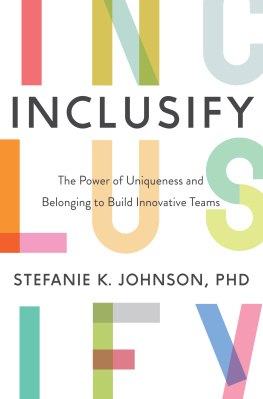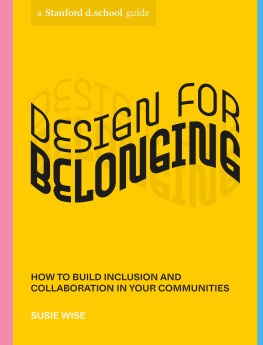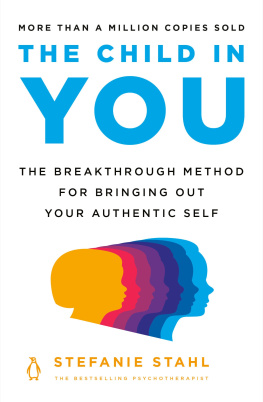Stefanie K. Johnson - Inclusify: The Power of Uniqueness and Belonging to Build Innovative Teams
Here you can read online Stefanie K. Johnson - Inclusify: The Power of Uniqueness and Belonging to Build Innovative Teams full text of the book (entire story) in english for free. Download pdf and epub, get meaning, cover and reviews about this ebook. year: 2020, publisher: HarperCollins, genre: Business. Description of the work, (preface) as well as reviews are available. Best literature library LitArk.com created for fans of good reading and offers a wide selection of genres:
Romance novel
Science fiction
Adventure
Detective
Science
History
Home and family
Prose
Art
Politics
Computer
Non-fiction
Religion
Business
Children
Humor
Choose a favorite category and find really read worthwhile books. Enjoy immersion in the world of imagination, feel the emotions of the characters or learn something new for yourself, make an fascinating discovery.
- Book:Inclusify: The Power of Uniqueness and Belonging to Build Innovative Teams
- Author:
- Publisher:HarperCollins
- Genre:
- Year:2020
- Rating:4 / 5
- Favourites:Add to favourites
- Your mark:
- 80
- 1
- 2
- 3
- 4
- 5
Inclusify: The Power of Uniqueness and Belonging to Build Innovative Teams: summary, description and annotation
We offer to read an annotation, description, summary or preface (depends on what the author of the book "Inclusify: The Power of Uniqueness and Belonging to Build Innovative Teams" wrote himself). If you haven't found the necessary information about the book — write in the comments, we will try to find it.
Inclusify: The Power of Uniqueness and Belonging to Build Innovative Teams — read online for free the complete book (whole text) full work
Below is the text of the book, divided by pages. System saving the place of the last page read, allows you to conveniently read the book "Inclusify: The Power of Uniqueness and Belonging to Build Innovative Teams" online for free, without having to search again every time where you left off. Put a bookmark, and you can go to the page where you finished reading at any time.
Font size:
Interval:
Bookmark:
To the loves of my life, Piet, Katy, and Kyle Johnson.
I hope you create and enjoy a more Inclusifyed world.
Contents
Another day, another corporate cafeteria. The setting was typical, the actors were the same, even the costumes were typecast: large beige building with lots of free snacks and high-performance beverages; the human resources (HR) specialist in her blue skirt suit, me in black heels, black pants, and a jaunty jacket. But there was something a little different about that day back in July 2016.
I was interviewing top-level executives and subordinates at a Fortune 100 company to learn how the best leaders get results while leading in a diverse environment, part of my research at the Leeds School of Business at the University of Colorado Boulder. I had just taken an all-day flight to New York after doing some work in the Netherlands, so I wasnt sure if my jet-lagged brain was firing on all cylinders.
As I entered the cafeteria, I tried to listen intently to the HR specialist who was filling the dead air with details about all of the new programs the company was running: pulse surveys, mentorship programs, leader training, job rotations.
But in that moment, I was preoccupied with one of my meetings earlier that day. I had interviewed an executive, Jim, who had said impressive things about his approach to leading in a diverse environment. He had seemed great. But then I had interviewed a member of his team, Tawny, who had told me a whole different story. Im asked for my opinion, but in the end my opinion never matters, shed said. It made me wonder: Was Jim a bad leader? Was Tawny an underperforming employee who liked to complain? Or was it a bit of both? Clearly, there was a disconnect. I wanted to know more.
As I paid for my sandwich and bag of Doritos, the musical sound of a multitude of different languages caught my ear. Looking around, I found myself in a room filled with people of all different ages, races, and genders. I was not at all surprised at the diversity of the crowdwe live in a diverse world, and this was a global company based in New York. But what stood out to me that day, even though I had seen it many times before, was that most people were seated in homogeneous groups. There were a table of Asian Americans, a table of young white women, a table of Latinos, a table of old white guys, a table of young white guys.
It made me wonder: If we are all segregating around the lunch table, do we do the same around the conference table? I knew that when it comes to starting companies, women, people of color (POC), and women of color (WOC) are more likely to start teams together.
Likewise, venture capitalists are more likely to partner with founders who share the same background. But they do so at their own peril. For example, a group of venture capitalists is 25 percent less likely to invest successfully when all members are of the same race than when there is diversity on the team. Why? Because they are missing out on different perspectives. We see the same negative effects in homogeneously educated groups: venture capital teams are 18 percent less successful when they invest with another venture capitalist who graduated from the same alma mater.
So if the lunch table behavior I was witnessing extended to the meeting table, this organizations teams were probably not performing as well as they could. It might also help to explain the confusing interviews Id just conducted with Tawny and Jim. In fact, it might explain why, in general, most corporate diversity efforts fail.
I thought Jim had said all the right things about leadership during our conversation. But Tawnys experiences did not jibe with her bosss words. I felt as though she was talking about a completely different person than the one I had met. It was classic he said, she said.
HE SAID: I really like people to try new things. That is how we innovate.
SHE SAID: Lets just say, if someones new idea doesnt work, there will be consequences.
HE SAID: I am all about empowermentI like to let people do things their own way.
SHE SAID: We really get no guidance at all. He calls it empowerment, but I just feel lost.
HE SAID: I always ask for everyones input on decisions. But at the end of the day, it is my job to decide.
SHE SAID: I am allowed to be in the room and give my opinion, but Im not really included because in the end my opinion never matters.
Tawny wasnt done. She added that her performance wasnt recognized. She told me that shed landed a large client, yet Jim had never even mentioned it. She also complained that she did not feel like part of the team. In fact, she said, there is no team, just a bunch of people trying to outperform each other to please Jim. But were all on our own. It feels like The Hunger Games.
As a result, Tawny, like so many others in the United States today, was not engaged in her work; she was just going through the motions to get through each day and was no longer taking on new challenges. It weighed on her that we spend the majority of our waking lives at work, and shed had enough. She had decided it was time to look for a new job.
For the last fifteen years, I have been studying the intersection of leadership and diversity: how teams perceive female and minority leaders and what leaders can do to increase the variety of race, ethnicity, experience, background, and perspective in their workforce. In that time, despite the notable increase in companies making diversity a priority and implementing diversity programs, the Fortune 500 has not made much progress. There is still a dearth of women, POC, WOC, and LGBTQ in the top ranks of organizations. As of 2019, women and POC comprise only 25 percent and 27 percent of executives, respectively. Only 5 percent of CEOs are women. Five percent! This is despite the fact that women make up 51 percent of the population and minorities make up 39 percent of the population. For example, 13 percent of the populationbut fewer than 1 percent of Fortune 500 CEOsis black.
Even at companies that try hard to recruit women, POC, WOC, and LGBTQ, leaders report that the diversity management efforts are not working. In April 2016, I spoke at the White House summit on diversity in corporate America to an audience of Fortune 500 chief executive officers, chief diversity officers, and other thought leaders. Our conversations made it clear that they, too, were struggling to get the most out of their diversity efforts. Their teams werent bonding, their employees engagement was low, and some employees felt excluded.
After meeting Tawny, I became curious to learn more about what leaders could do to fully harness the power of diverse perspectives and ensure that they keep their talented employees and attract new ones. Its not just CEOs who need to solve this problem. CEOs may change policy, but it is the managers throughout the organization who have the strongest impact on teams. I went on a quest to understand why some leaders are able to attract, retain, and engage diverse teams while others miss opportunities or fail altogether. I read the research, conducted laboratory experiments, did field studies with a multitude of organizations, and interviewed more than a hundred leaders and followers, including the CEOs of major corporations who were getting it right, according to their employees and profit-and-loss reports, and leaders at all levels who were getting it wrong. I uncovered the two skills that the best leaders had in common.
First, they embrace different perspectives and backgrounds. Second, they fit all the unique pieces together to create a cohesive, interdependent team with a shared purpose. Together, this set of behaviors enables people to do what I call Inclusify. Unlike diversifying or including, Inclusifying implies a continuous, sustained effort toward helping diverse teams feel engaged, empowered, accepted, and valued. And although few people are born Inclusifyers, there are specific steps that leaders can take to become one.
Next pageFont size:
Interval:
Bookmark:
Similar books «Inclusify: The Power of Uniqueness and Belonging to Build Innovative Teams»
Look at similar books to Inclusify: The Power of Uniqueness and Belonging to Build Innovative Teams. We have selected literature similar in name and meaning in the hope of providing readers with more options to find new, interesting, not yet read works.
Discussion, reviews of the book Inclusify: The Power of Uniqueness and Belonging to Build Innovative Teams and just readers' own opinions. Leave your comments, write what you think about the work, its meaning or the main characters. Specify what exactly you liked and what you didn't like, and why you think so.











